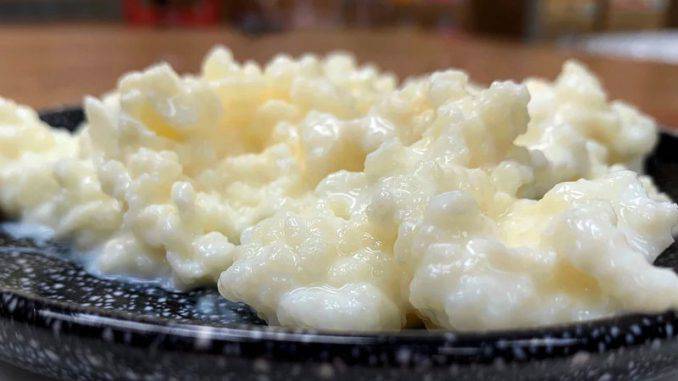
What is milk Kefir?
Milk Kefir (also called kephir, kewra, talai, mudu kekiya, milkkefir, búlgaros) is a fermented dairy product originating from the Turkic, Mongolian, and Tibetan peoples inhabiting Central Asia. Kefir has been recently revived and is becoming viral thanks to new research and discoveries about its probiotic powers and the multitude of health benefits it provides.
Milk Kefir is a cultured milk product that tastes similar to diluted yogurt, but it contains beneficial probiotic bacteria and yeast in much larger quantities than yogurt. It is also loaded with valuable vitamins and minerals and contains easily digestible proteins that make it an irreplaceable addition to any diet.
Years ago, Kefir was especially popular in the former Soviet Union and many countries of Eastern Europe. Today its variations account for 70% of the total fermented milk consumed in Russia and are relatively widespread in Sweden, Norway, Finland, Hungary, Poland, Bulgaria, Turkey, Greece, Brazil, and Israel.
Kefir was introduced to the Western world, notably the United States, in the late 20th Century. It is now considered one of the most promising sources of probiotics the western world has ever met.
You can make Kefir with any dairy milk, including cow, goat, or sheep, as well as non-dairy types of milk like coconut, rice, or soy milk. Historically, caucasian and Asian nomad tribes used to make kefir drinks with horse milk, and then it was called koumiss.
Kefir is made through the coagulation of various types of milk in the presence of Kefir culture called “Kefir grains”, or “Kefir SCOBY” which stands for Symbiotic Colony Of Bacteria and Yeast.
What are the Kefir grains?
Opposite to yogurt made directly from the lactic acid bacteria of an older batch of yogurt, Kefir can only be made in the presence of Kefir grains. Kefir grains are gelatinous white or yellowish cauliflower-like formations that make Kefir unique, as no other milk culture is being made with such grains and has so many probiotic benefits.
Some commercial producers have recently begun selling lyophilized cultures made from Kefir grains. These “mother cultures,” often called “Kefir starters,” are used to inoculate the milk directly. This approach allows more control over the fermentation process, provides more consistent quality, and is predominantly applied commercially.
The downside of the lyophilized commercial starters is that their cultures do not grow and regenerate and can therefore be used for no more than 3-4 brews. Unlike these starters, natural Kefir grains grow and renew constantly. If regularly fed with fresh milk, they regenerate and can practically last forever.
Some species of Kefir grains can develop and ferment in sweetened water. However, these are called “Water Kefir grains” and should not be confused with milk Kefir grains, as they are entirely different. The microbiological composition of Water Kefir grains is also significantly different.
Since the term “Kefir” is usually associated mainly with milk Kefir, we only discuss milk Kefir in this article. You can find more information about water Kefir in our article titled “What is Water Kefir and how to make it?”
Milk Kefir grains contain bacteria and yeast held together by casein (milk proteins) and complex sugars. Their size may vary from a grain of wheat to that of a hazelnut.
Scientifically speaking, Kefir grains are “a combination of bacteria and yeast in a matrix of proteins, lipids, and sugars“. This symbiotic matrix forms colonies resulting in these cauliflower-like grains with a white or creamy color.

The microorganisms present in Kefir are beneficial Lactic Acid Bacteria (LAB), mainly from the Lactobacillus species. Kefir is also enriched with vitamins, amino acids, carbon dioxide, acetoin, and essential oils, which all have been proven to have a series of health benefits.
How can I get Kefir grains?
You cannot produce Kefir grains – you must get them from another Kefir user or buy them. During fermentation, Kefir grains tend to grow and multiply constantly. So, all Kefir users sooner or later end up with an excess of Kefir grains that they are usually ready to share with other Kefir enthusiasts.
Alternatively, you can buy either Kefir grains or Kefir starter cultures from online stores like Amazon.
The grains are white or creamy, small to medium walnut in size, but they can also be much smaller – as big as rice or wheat grains. In the process of fermentation, they usually increase in size and multiply.
How is Kefir Made?
Kefir is prepared by inoculating milk with the Kefir grains, and the preparation of the Kefir drink is pretty straightforward. You mix the Kefir grains with a specified quantity of milk at room temperature and let the mixture ferment for about 24 hours or even less (depending on temperature).
The quality of the Kefir drink depends on the fermentation time, the ambient temperature, and the Kefir-to-milk ratio. You can get more information about the Kefir-to-milk ratio and the required fermentation time in our article titled “How to prepare Milk Kefir?”
The microbial cultures of Kefir are known to be mesophilic, which means that they thrive and grow best at ambient room temperatures – from 20 to 30 °C (68 to 86 °F).
The fermentation of milk in the presence of the Kefir grains results in a sour, carbonated, slightly alcoholic beverage, with a look and taste similar to diluted yogurt. The alcohol content of Kefir fermented for 24 hours is from 0.02% to 0.07%, which is considered negligible.
Fermentation causes changes in the composition of almost all ingredients of milk. The sugar of milk, called lactose, is broken down into lactic acid, which results in the acidification of the final product. As a result, very little lactose remains in Kefir, so people with lactose intolerance can much better tolerate Kefir than unfermented milk.
We can also obtain milk Kefir by using non-dairy milk like soy milk or coconut milk, making it acceptable for lactose-intolerant people and vegans.
How to handle Kefir grains?
Kefir grains should not contact any metal tools – like metal strainers or spoons. Use a plastic strainer and a plastic or wooden spoon instead. Have in mind though, that stainless steel is less reactive and is unlikely to hurt the Kefir grains. So, the use of stainless steel utensils and cutlery is allowed.
When Kefir grains are not used, they can be stored dried or in a milk solution.
They can be stored in milk solution for about 5 – 7 days in the refrigerator at 4° C, after which we should replace the milk.
Refrigerated storage can last up to about a month, with a milk change every 7 to 10 days.
You can find more information about this topic in our article “Can Kefir be stored in the fridge“.
Drying and freezing Kefir for more extended storage
To dry the Kefir grains, rinse them in pre-boiled and cooled water. Let them dry wrapped in clean cheesecloth or paper napkin for a few days at room temperature.
Once they dry and acquire a typical yellowish color (after about 2-3 days), put them in a plastic bag, sprinkle them with powdered milk, and place them in the freezer. This way, they can be stored for about 12 to 18 months or more.
Reactivating Kefir after long storage
You can reactivate the Kefir grains by washing off powdered milk and placing them in fresh milk at room temperature. It takes several cycles of 24 hours to replace the milk until they are fully reactivated and acquire their characteristic texture and smell. The smell of yeast disappears, and the proper bacterial balance of the culture is restored. It is not recommended to drink the mixture during the first week of reactivation.
Further details about storing Kefir grains are available in our article “How to store the Kefir grains?“.
Kefir grains can be contaminated with unwanted bacteria that reduce the life of its beneficial bacteria. To protect against unwanted contamination, thoroughly wash and sanitize all jars and containers used to prepare your Kefir.
What are kefir and kefir grains? – Summary –
- Kefir is a fermented dairy product that is extremely rich in probiotics;
- Kefir originates from Central Asia and has been known for centuries;
- Kefir was introduced to the Western world by the end of the 20th Century;
- Kefir is prepared by inoculation of dairy or non-dairy kinds of milk in the presence of Kefir grains;
- Kefir grains are a symbiotic culture of bacteria and yeast (SCOBY);
- Kefir grains are mesophilic cultures that ferment at average room temperatures – from 20 to 30 °C (68 to 86 °F);
- The best way to keep Kefir grains healthy is to feed them by continuously preparing new batches of kefir drink;
- For relatively short periods (up to a week), Kefir grains can be stored in a jar full of milk in the refrigerator.
- Alternatively, for extended periods of storage (months or even years), kefir grains should be dried and frozen;
What are the health benefits of Kefir?
Kefir has been known since ancient times and has been used to treat a vast range of diseases.
In the former Soviet Union, authorities used it in hospitals as direct medication for various conditions, including metabolic disorders, atherosclerosis, and allergic disease. It has also been used to treat tuberculosis, high cholesterol levels, gastrointestinal and metabolic diseases, hypertension, ischaemic heart disease, and many allergies.
Kefir contributes to a more stable food movement in the intestine, and lactic acid and acetic acid inhibit the putrefactive processes in the small intestine.
While Kefir looks very similar to yogurt, the main nutritional difference is that Kefir contains much more probiotics than yogurt. Yogurt also contains some probiotics, but the probiotics in Kefir vastly outnumber the ones in yogurt.
The benefits of consuming Kefir regularly in the diet are numerous. Easily digested, Kefir cleanses the intestines, provides beneficial bacteria and yeast, vitamins and minerals, and complete proteins. As a balanced food rich in nutrients, it contributes to a healthy immune system and has been used to help patients who have chronic fatigue syndrome, herpes, and even cancer.
The regular use of Kefir can help relieve many intestinal disorders, promote bowel movement, reduce flatulence and create a healthier digestive system. In addition, its cleansing effect on the whole body helps establish a balanced inner ecosystem for optimum health and longevity.
Kefir is exceptionally beneficial for the complete intestinal and urinary systems and positively affects weight loss.
Other essential health benefits manifested by Kefir are its antimicrobial and anti-carcinogenic effects.
Kefir also provides many healthful benefits in cholesterol-lowering diets and in improving lactose tolerance to many affected people.
Kefir products also contain many dietary minerals, vitamins, essential amino acids, and, as by-products of the fermentation process, carbon dioxide and small amounts of ethanol (alcohol).
However, the most important beneficial effects of Kefir are a result of the probiotics it contains.
The range of probiotic bacteria in Kefir may consist of up to 50 different strains. The most noticeable and most powerful ones are Lactobacillus acidophilus, Bifidobacterium bifidum, Streptococcus thermophilus, Lactobacillus bulgaricus, Lactobacillus helveticus, Lactobacillus kefiranofaciens, and Lactococcus lactis.
A series of studies have shown that probiotic foods like Kefir are beneficial in treating a long list of gastrointestinal disorders.
One example is diarrhea, which a variety of conditions can cause. Kefir helps prevent diarrhea and reduces its duration, and alleviates conditions such as infant’s diarrhea, irritable bowel syndrome, colitis, Crohn’s disease, gastroenteritis, etc. Its regular intake relieves stomach disorders, reduces bloating, ensures a healthy digestive system, and reduces the appetite for harmful and unhealthy foods.
In addition to beneficial bacteria and yeast, Kefir contains minerals and essential amino acids that help the body with many of its functions.
The complete proteins in Kefir are partially transformed by fermentation and therefore more easily absorbed by the body.
Kefir contains the essential amino acid Tryptophan, well known for its relaxing effect on the nervous system. Due to the presence of Tryptophan, its soothing effect on the nerves has benefited many who suffer from sleep disorders, depression, and ADHD (attention deficit hyperactivity disorder). Kefir also offers an abundance of calcium and magnesium, essential minerals for a healthy nervous system, and has a substantial relaxing effect.
The ample presence of phosphorus in Kefir, the second most abundant mineral in our bodies, also helps our gastrointestinal systems absorb carbohydrates, fats, and proteins.
Kefir is rich in Vitamin B12, B1, and Vitamin K. It is an excellent source of biotin, a B Vitamin that aids the body in absorbing other B Vitamins, such as folic acid, pantothenic acid, and Vitamin B12.
The numerous benefits of maintaining adequate B vitamin intake range from regulating the kidneys, liver, and nervous system to helping relieve skin disorders, boosting energy, and promoting longevity. Research is still in progress, but it has been proven that Kefir drink cures some types of allergies, skin diseases, acne, colitis, and even prevents colorectal cancer.
Kefir is highly recommended as an immune modulator for strengthening and maintaining a healthy and well-balanced immune system. It is also known to have antagonistic effects against many harmful bacteria and fungi, including Salmonella.
Kefir is a balanced and healthy food, sustaining a healthy gastrointestinal tract and a well-balanced immune system.
Health benefits of Kefir – Summary –
- Kefir is a rich source of valuable nutrients;
- Kefir is the richest source of probiotics, much richer than yogurt;
- Kefir may contain up to 50 different strains of beneficial bacteria and yeasts, known as probiotics;
- Probiotics in Kefir help in solving numerous digestive problems;
- Kefir has powerful antibacterial properties;
- Kefir may help in the fight against cancer;
- Kefir contains very little lactose and is well accepted by lactose-intolerant people;
- Kefir can improve the symptoms related to allergies and asthma;
- Kefir has a relaxing effect on the nervous system and improves sleep;
- Kefir can also be applied directly to the skin a may solve a lot of skin problems;
- Kefir is the easiest and cheapest way to obtain probiotics at home;
What could be the downsides of Kefir?
Kefir has virtually no contraindication for healthy people.
If you have never taken Kefir before, its first uses may put your stomach in “overdrive” mode, which may temporarily lead to flatulence or even diarrhea. These symptoms are, however, transitory and usually fade away once your stomach adapts to Kefir.
It is important to stress, though, that people with a compromised immune system and those undergoing immunosuppressive treatment should be highly cautious with Kefir and should eventually avoid it!



